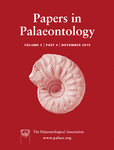Reg. Charity No. 1168330

The apparatus composition and architecture of prioniodinin conodonts is poorly understood, largely because few prioniodinin taxa are represented by articulated oral feeding apparatuses (natural assemblages) in the fossil record, but also due to the highly variable gradational morphology of their constituent elements that makes apparatus reconstruction problematic. We describe here a natural assemblage of Erismodus quadridactylus (Stauffer), a prioniodinin, from the Sandbian (Late Ordovician) of North Dakota, USA. The assemblage demonstrates that the apparatus architecture of Erismodus is similar to those of late Palaeozoic prioniodinins namely, Kladognathus Rexroad and Hibbardella Bassler, but also has similarities with ozarkodinin apparatuses. In addition, there is evidence to suggest that E. quadridactylus shares topological similarities to balognathid architecture, with respect to the position of its inferred P elements. The apparatus composition and architecture presented here indicate that, at least with respect to the M–S array, an ‘ozarkodinin‐type’ bauplan is probably more widely representative across prioniodontids. The assemblage demonstrates that element morphotypes traditionally considered to lie within the S array are M elements, whereas others traditionally interpreted as P elements are found in the S array. These observations are used as a basis for refining concepts of element homology among prioniodinin conodonts and their closest relatives.